 |
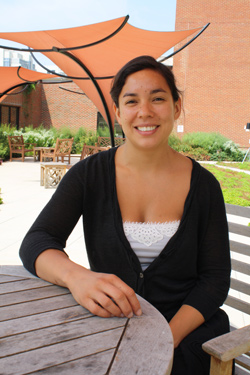
|
|
Jennifer Sargent, Immunologist, National Institute of Arthritis and Musculoskeletal and Skin Diseases (NIAMS), National Institutes of Health (NIH)
|
1. I chose this career because...
2. My typical workday involves...
3. What I like best/least about my work...
4. My career goals are...
5. When I'm not working, I like to...
|
|
1. I chose this career because...
|
Back to Top

|
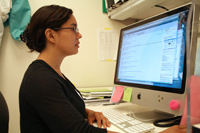
|
|
Jennifer spends time at her desk, analyzing data and reviewing the latest published research in her field.
|
I chose to become an immunologist because I wanted to perform research that would impact the lives of people suffering with autoimmune and other immunological disorders. While working on my doctoral degree, I studied the signaling pathways in the skin of patients with scleroderma. I enjoyed using bioinformatics to address this complex problem. However, I was frustrated with my inability to translate research into discoveries that would impact clinical decision-making and patient care. I felt that learning “wet bench” immunology in my postdoctoral studies would carry my research full circle -- from hypothesis to patient relevance in the clinic.
Finding a passion through interdisciplinary studies
From an early age, I was interested in the sciences. I did not take biology classes in high school because I preferred the physical sciences and math. When I was accepted into an accelerated science program at my undergraduate university, I was intrigued by the idea of applying chemistry theory to biological questions. Pursuing a major in drug design and development seemed a natural choice. The curriculum for my major exposed me to many new fields and topics. In my second semester of biochemistry, I was introduced to the molecular mechanisms of transcription and translation -- cell processes that convert genetic information into proteins. I was hooked. I immediately switched my major to biochemistry and sought out mentors in the department.
Acquiring lab experience
During a summer break, I worked in a lab studying brain receptors that influence susceptibility to alcoholism. This was my first exposure to real research science, and it cemented my decision to pursue an academic research career. I selected the remainder of my courses to focus on practical research topics whenever possible. At the time, the field of computational biology was emerging and undergraduate classes on the subject were being taught. In my last year of undergraduate study, I completed the advanced topics in bioinformatics and helped develop introductory courses for incoming science majors.
To enter graduate school in Australia, you must complete either an honors year of full time research or have a relevant masters degree. I opted to enroll in the honors year and wrote my dissertation on the infectious mechanisms of a disease-causing bacterium. After completing my research, I was recruited to work at a graduate university and research center in San Francisco. I had planned to stay there for only one year, but enjoyed it so much, that I stayed for nearly 4 years. My colleague there encouraged me to continue my graduate studies in the United States.
Education
- Doctor of Philosophy, Genetics, Dartmouth Medical School, Hanover, New Hampshire
- Bachelor of Science, first-class honors, Biochemistry (1 year program with thesis defense, Master’s equivalent), University of Queensland, Australia
- Bachelor of Science, Biochemistry, University of Queensland, Australia
|
|
2. My typical workday involves...
|
Back to Top

|
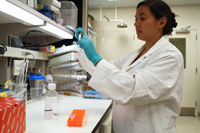
|
|
Jennifer pipets a solution for extracting ribonucleic acid (RNA) from cultured mast cells.
|
My typical workday as a postdoctoral scientist is focused on research projects to understand the role of a signaling molecule in allergic responses and autoimmune diseases. My major project is studying the role of certain enzymes in skin allergies.
My major tasks include
- Conducting experiments - About 75% of my time is spent planning and performing experiments in the laboratory. Some of these experiments require the use of mice models. I give them various treatments and measure the progression of dermatitis. I watch for inflammation or the presence of certain cells in affected tissues. My molecular-based experiments are performed in cultured cells.
- Data analysis - A large portion of my time is dedicated to analyzing the data from my experiments. I often use specialized software to interpret and graph my results.
- Literature review - A very important part of research is reviewing how my work contributes to the knowledge pool, and to explore other published works in the field. I check PubMed several times a week to observe trends and emerging research in my field. That helps me develop and refine my own research plans.
- Meetings and discussions - I attend several seminars a week to learn about a broad variety of research topics. Once-a-week, our lab members meet to discuss current literature or present their own research. It is important that we get feedback on our data and discuss the direction of our projects. I meet with my mentor several times a month to discuss research progress and career development.
|
|
3. What I like best/least about my work...
|
Back to Top

|
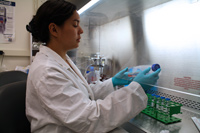
|
|
Jennifer uses a laminar flow hood, which provides a sterile environment, to care for cultured mast cells used in her research.
|
What I like best about my work is that doing research means I’m learning something new every day. I am never bored. I have the opportunity to work with people from many different backgrounds, cultures and countries. The NIH is a special place because it has a very multicultural and international feel, which makes it a fun and interesting work atmosphere. This career offers me the opportunity to interact with many people on a daily basis. I am rarely alone in the lab and have avid science discussions with my colleagues and mentor every day. This career path also gives me many opportunities to travel and present my research at various conferences in the United States and abroad.
What I like least about my work is staying motivated when experiments are not working. Since we are doing novel research, there is no guarantee that every experiment will work. Sometimes the data we generate is difficult to interpret or does not give the outcome we predicted. This can be very frustrating. With persistence and hard work, experiments can work. The reward of success and being able to publish the results is very satisfying.
|
|
4. My career goals are...
|
Back to Top

|
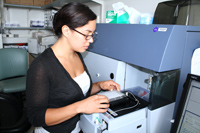
|
|
Jennifer uses a machine to perform flow cytometry, which is a method to differentiate the types of immune cells in a culture.
|
Ultimately I would love to run my own academic research lab in a university or medical school. I am very interested in mentoring and working with graduate and medical students at the bench, teaching them how to think about science, generate hypothesis, and solve problems.
|
|
5. When I'm not working, I like to...
|
Back to Top

|
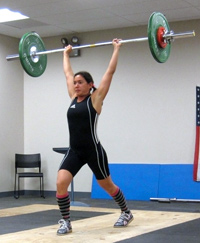
|
|
Jennifer competes in an Olympic weightlifting event at the Keystone State Games.
|
When I’m not working, I train and compete in Olympic weightlifting. This is an activity that keeps me fit, strong and healthy. I train 3-4 times a week with my coach and am planning to compete in a national level competition by the end of the year. Competing adds another perspective to my workouts. It has made me more goal-oriented and driven, in the gym, and in other aspects of my life. When I am not in the lab or gym, I enjoy preparing meals with my friends, reading, watching movies, and spending time with my two cats.
|
|
|
|
 |